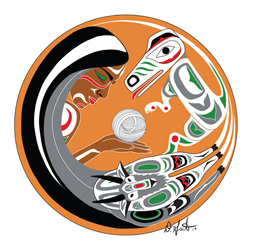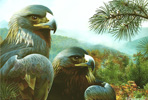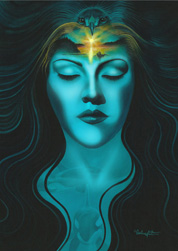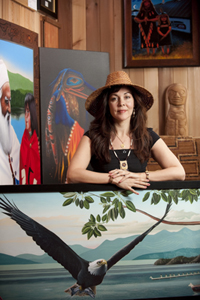


|
Welcome to One Moon Gallery,
Through her art Darlene Gait represents the beauty of the North West and its aboriginal people while also showcasing the traditional iconographic images of the art of the Coast Salish first people of the North West Coast. Her paintings are a visual feast of such art forms as Salish totem poles, native Indian mask carvings, bent wood boxes, bead work, dream catchers of the Esquimalt, the Quw’utsun, the Kwakwaka'wakw, the Pauquachin, the Tsarlip, the Songhees, as well as many other Coast Salish Nations living in the lower mainland as well as Vancouver Island. Gait's art represents her people wearing native regalia, dancing at the potlatches, gathering berries in hand-made cedar baskets, wearing cedar hats and clothing, playing their traditional native drums and rattles, celebrating the traditions, music, dancing, feasting and gift giving at Potlatches, and canoe making and racing by the aboriginal people of the North West Coast. The art of native Canadian artist Darlene Gait also celebrates the art and traditions of the First Nations people of the Plains and Woodlands regions in Manitoba and Ontario as well as Inukshuks by the indigenous people of the Arctic North, the Inuit people. Her landscapes are also filled with the trees, flowers, plants indigenous of the North West coast as well as its wild life. The grizzlies, the black bears as well as the spirit bears, the wolfs, the orcas, the pacific salmon, the deer, the moose, the eagles, the lynx, the cougars, are all portrayed with emotion and in their own natural environments. She is unique in her depictions of Canadian wildlife, set in the landscapes of the North West and charged with the cultural richness of her heritage. These creatures are not only of interest to her as she makes an effort to find them in their natural habitat but also due to the mythical stories passed on from time immemorial by her ancestors and which are part of her art and visual story telling. Inspired by nature and her First Nations heritage, her work is created with emotions that allow the viewer to connect and relate to the stories told through her brush. Her poetry, created with each painting, allows people to understand each image through the artist's perception. She is recognized internationally; her art is exhibited and held in private and public collections, and her limited edition Giclees and prints are sold in galleries worldwide. Darlene's paintings and poetry celebrate her love for her Coast Salish culture and bring to life through beautiful images the rich traditions and oral history of the First People of Canada. Her art also reflects her passion for protecting the environment and wildlife as well as her beliefs in the oneness of humanity and the beauty of its diversity. Her paintings are often inspired by her vivid dreams, which she believes must be captured by her brush and poetry and then shared. She also feels bound by the responsibility to depict all her images with scientific and historical accuracy, as she considers her art to be part of the oral history of her culture. Among her many accomplishments Darlene Gait has illustrated a number of children's books for Orca Publishing. These include the best sellers Secret of the Dance with native judge Alfred Scow and Andrea Spalding as well as "Who is In Maxine's Tree" among others. She also worked with master Coast Salish carver Butch Dick of the Songhees Nation to design a Peace Mural for the Creative Peace Mural Society and is presently commissioned by the Greater Victoria Harbour Authority to design the Land and Sea mural on the Ogden Point breakwater at the Victoria Harbour. Darlene is an active member of the board of Partners for Prosperity, Art for Development Foundation and contributes her time and art to support many local and international initiatives that work for community development, the eradication of prejudice, bringing unity amongst various ethnic groups, for advancing the education of children and youth and for social justice. Read what the media has written about Native American artist Darlene Gait; "... She incorporates Coast Salish elements to illustrate the interdependence of her culture and the environment. ... Gait...is as inspired as she is inspirational." By Richard Walker for Indian Country Today more.... "The distinctive artwork of Canadian First Nations artist Darlene Gait has been described as "about all things good" by Robert Amos art critic for the Victoria Times Colonist more.... "Transferring words into visual images is her way of storytelling. And those stories are very powerful. ... The transformational power that allowed her aboriginal ancestors to move in and out of the spirit realm is apparent in the images she selects to tell her stories: animals with grace and wisdom, children with genetic memory, and landscapes that are one with plant and animal life." By Linda Rogers for Focus Magazine more.... "Esquimalt Nations artist Darlene Gait paints colorful and spiritual images that capture the pride of her people. First Nations artist Darlene Gait of Vancouver Island, BC, is inspired by her Coast Salish culture. The acrylic paintings done by this Esquimalt Nations artist come alive with vibrant colours, poignant subject matter, and strong designs, making them immediately recognizable and in demand worldwide." By Penny Rogers for Canadian Brushstroke Magazine more.... The art of Darlene Gait has also been featured on six occasions on the cover of Indian Gaming magazine, on several occasions on Shaw TV, APTN, The New Canoe, The A Channel, CBC radio, as well as many other local and international publications. If you live near Victoria or you are able to visit Vancouver Island, you will enjoy the very unique pleasure of visiting her permanent exhibition at the One Moon Gallery. To walk into Darlene's One Moon Gallery is to enter her world of dreams and inspiration - to view the natural world from her unique perspective, a point of view that represents connectedness, harmony and beauty. The location is spectacular as it is facing the ocean front park that belongs to the Esquimalt people but until now was only accessible by those residing on the reserve. Even long time Victoria residents are impressed and happy to discover a serene and authentic native village close to downtown, now open for them to visit. A visit to the gallery itself is also an unforgettable experience as it is made in the style of a long house, with a Totem Pole erected for the opening of the gallery. The front doors are made of carved cedar and the interior walls and ceiling are also fully covered by natural cedar. The lighting is state of the art, the art is beautifully presented and the music piped in is soft native flute which gives the visitor a calming and non rushed experience that invites to stay and enjoy each painting and the poetry that the artist has composed for each work. The art displayed is that of Coast Salish artist Darlene Gait who is an internationally recognized painter from the Esquimalt Nation and who placed her gallery in this setting as a way to honor her people and to also welcome non natives to visit her community. Note: The First Nations of Canada refer to those people that can trace their ancestry to the original people that inhabited the land that is now Canada prior to the arrival of Europeans and Americans in the late 18th century. These groups and their art are commonly referred to by other names, including Aboriginal Art, Native Art, American Indian Art and Indigenous People's Art. The term First Nations is more commonly used now to remove the misnomer of 'Indians', which arose from the misconception by Christopher Columbus that he had landed in India. The term First Nations also avoids the often derogatory connotation associated with the terms native, indigenous and aboriginal. We
hope that you enjoy your visit here and look forward to seeing you
at One Moon Gallery located on
|
Home | Bio | Galleries | New Releases | Shop | Multimedia | Events | Reviews | Links | Contact
©Copyright
Darlene Gait 1998 - 2010.
All rights reserved.
No image may be partially or totally
reproduced for any purpose without the express consent of the artist.




 Darlene Gait
is a contemporary Coast Salish First Nation's artist born in Vancouver Island in the Canadian North West. Her
art is collected and exhibited internationally, as well as in a permanent display at her One Moon Art Gallery
on the Esquimalt Nation Reserve, in front of the traditional Big House. Darlene's paintings are known as inspiring
and spiritual as she focuses and shares the beauty of the North West Coast landscape, its wild life and the
indigenous art of the Native Canadian people whose heritage she embraces in her paintings and poetry.
Darlene Gait
is a contemporary Coast Salish First Nation's artist born in Vancouver Island in the Canadian North West. Her
art is collected and exhibited internationally, as well as in a permanent display at her One Moon Art Gallery
on the Esquimalt Nation Reserve, in front of the traditional Big House. Darlene's paintings are known as inspiring
and spiritual as she focuses and shares the beauty of the North West Coast landscape, its wild life and the
indigenous art of the Native Canadian people whose heritage she embraces in her paintings and poetry.